Connecting Bold BI to Jira data source
The Bold BI dashboard designer supports connecting to both Jira and Jira Service Management (JSM) web services through the REST API.
Choose Jira data source
To configure the Jira data source, follow the below steps:
-
Click on the Data Sources button in the configuration panel to add a new data connection.
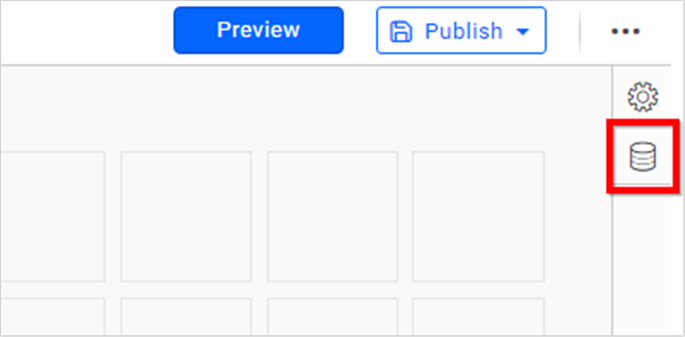
-
Click CREATE NEW to launch a new connection from the connection panel.
-
Select the Jira connection in the connection panel.
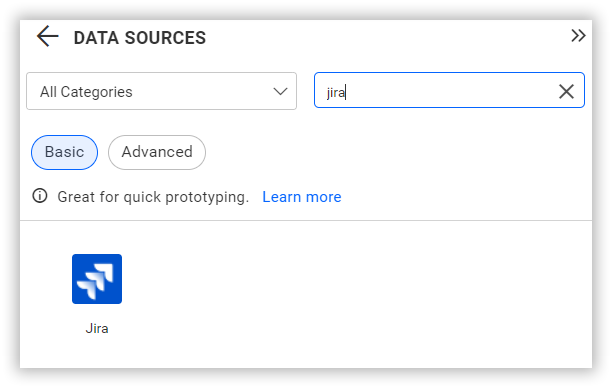
NOTE: You can also create a data source from the home page by clicking the Data Sources menu on the left menu panel and selecting Create Data Source from the data sources page.
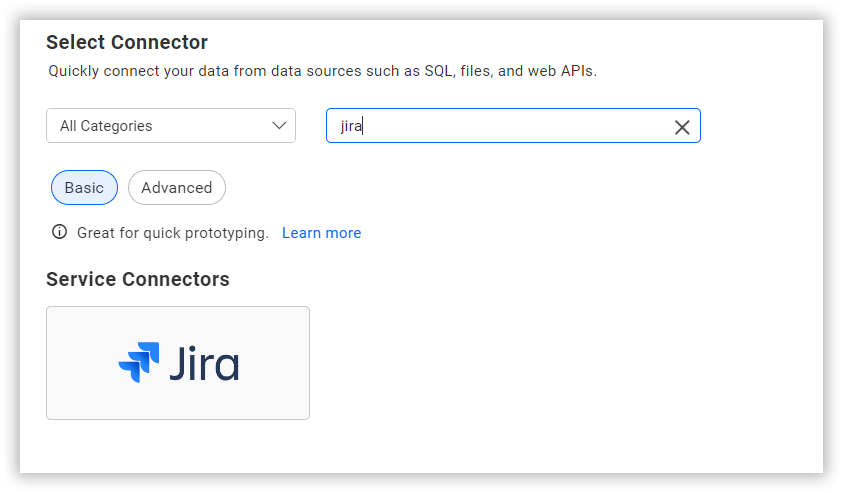
Create Jira data source
Once you click the data source, the NEW DATA SOURCE configuration panel will open. Follow the steps below to create a Jira data source.
-
Enter a name and description (optional) for the data source.
-
Enter a valid Jira REST API endpoint in the URL textbox. Refer to the Jira API documentation for more details.
-
Choose one of the Request Body type to make a request, either JQL or Raw Query.
-
Choose a time interval for the Refresh Settings using the combo box, to periodically trigger the REST API request and keep the data in sync with our dashboard.
-
Select JSON data type in Data Format combo box.
-
Choose Basic http Authentication under Authentication Type and input a valid Username and API Token.
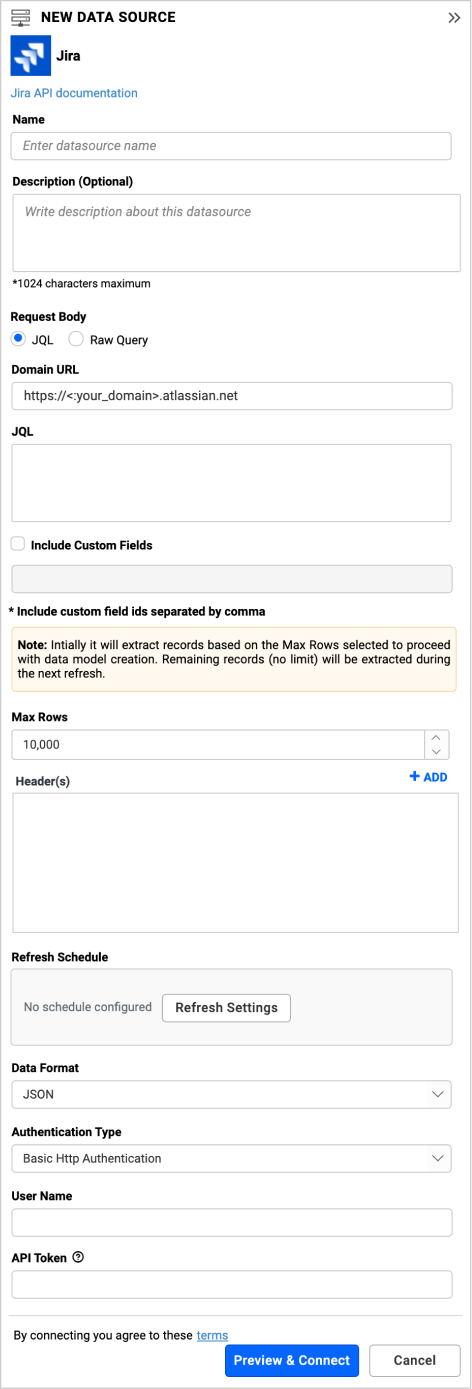
You can also edit the connection information set here using the Edit Connection option.
Request Body Types
JQL
-
Enter your domain name in the Domain URL textbox.
Example: https://<:your_domain>.atlassian.net
-
Enter a valid JQL Query in the JQL field.
Example:
project = weather -
If you need to add custom fields in JQL filtering, then enable Include Custom Fields and provide the custom fields in the enabled text box.
-
In Max Rows, enter the maximum number of rows to be fetched from the Jira data source. This value is used to fetch the data from Jira data source via pagination.
How to get the Custom field ID value from Jira?
-
In your Jira account, Go to the JQL query search under Filters -> Advanced Search.
-
Type a Custom field in the JQL search box and you can view the respective Custom field ID in the dropdown as shown in the following image.
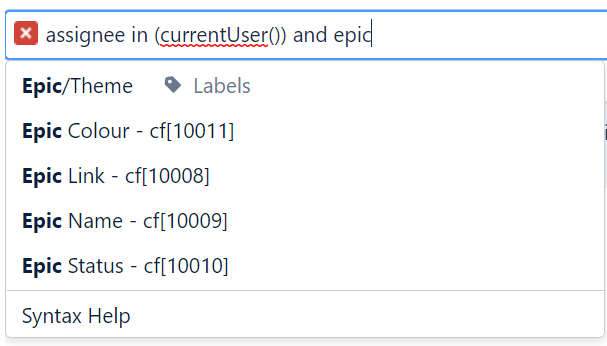
-
You can add the Custom field ID values in the Datasource connection window to retrieve the custom fields data.
The syntax for adding Custom Fields,
customfield_<Custom Field ID>Here, the Epic Link and Epic Name custom fields are added in the following image.

NOTE:
- The Custom field IDs must be separated by using a comma.
- If you have a Jira Admin account, you can also view the Custom fields ID by the ways mentioned in this knowledge base.
How To retrieve any field in Jira
To retrieve any field, including custom fields in Jira and pass the field details to the Include Custom Fields text box, follow these steps:
For Simple Data Type Fields:
- Add the desired simple data types field, such as text, number, or date, to the Custom Fields section.
Example: To fetch the value of the project -> name field, add project to the Custom Fields.

For Nested Fields:
-
Split the nested field name using a colon
:to identify the nested fields. -
Syntax:
<FieldName>:<InnerFieldName>:<Key>For example: To fetch the ID of the status Category of the status.status:statusCategory:id
Note:
- When accessing the inner fields of a nested field in Jira, separate the field names with colons
(:).- For fetching a custom field with a specific field ID, follow the same procedure by specifying the Custom field ID followed by a colon and the field ID. For example:
"customfield_10018:id".- Multiple values can be passed as default, nested array, or custom fields in the Include Custom Fields text box, and the values should be separated by commas (,). For example:
"customfield_10018:id, status:statusCategory:id".- When fetching the inner fields of an array, only the first element of the array will be fetched based on the field’s value.
Raw Query
-
Enter a valid URL in the URL field textbox.
Example:https://<:your_domain>.atlassian.net/rest/api/2/project
-
Select GET method for the REST API in Method combo box.
How do I get API Token for connecting Jira data source?
- Log in to Generate an API Token.
- Click Create API token.
- From the dialog that appears, enter a memorable and concise Label for your token and click Create.
- Click Copy to clipboard, then paste the token to your script, or elsewhere to save.
Additional information
| Max Rows | Most REST APIs return only a limited amount of data on a single API request. To retrieve the necessary amount of data, you can set a value in this field. Pagination is handled internally and will fetch the required data. |
| Refresh Settings | The period of time before the next refresh call is triggered. This will automatically trigger a call for the API configured in the data source to keep the data up to date. If you do not want to sync your new data, choose 'Never'. |
Setting up the URL
-
Replace <:your_domain> with your domain name in the URL.
-
For example, to retrieve the tasks or issues under a specific project, replace your JQL Query in the text area.
Sample Domain URL:
https://abcde.atlassian.netSample JQL:
project = weather
For more information on the API endpoints available for this data source, refer to their official API Documentation
Sample JQL queries
List tasks based on status modified
project = weather AND status CHANGED FROM “In Progress” TO “Open”
List tasks based on status on specified week
project = weather AND status was “In Progress” DURING (startOfWeek(), endOfWeek())
List tasks based on resolution
project = “weather” AND resolution changed to “Done” by currentUser() during (startOfYear(), endOfYear())
List tasks based on fixVersion
project = weather AND fixVersion = latestReleasedVersion(weather)
Preview and data import
-
Click Preview & Connect to connect with the configurations that have been set.
-
The Choose Schema(s) dialog opens. The schema represents the key fields of data retrieved from Jira Rest API request. This dialog displays a list of schemas in a treeview and its corresponding values in grid for preview. Select required schema(s) from treeview to use in designer and click Connect.

-
Now, the data design view page with the selected table schema opens. Drag and drop the table.
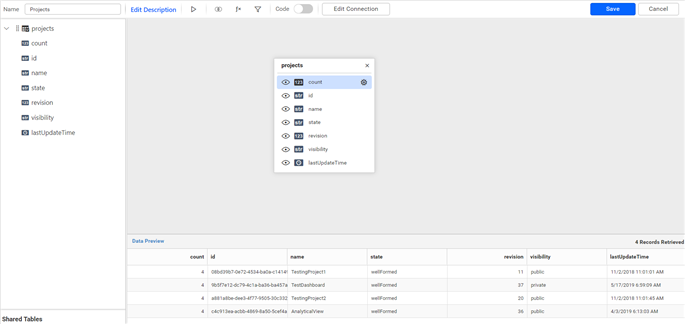
-
Click Save to save the data source with a relevant name.
Connect using custom attribute and dashboard parameter
We have added support for custom attributes and dashboard parameters to the data source connection. You can connect to the data source using custom attributes or dashboard parameters.
Custom Attribute

Dashboard Parameter

Note: Refer to the Dashboard Parameter Documentation and Custom Attributes Documentation for more details.
Related links
- Choose Jira data source
- Create Jira data source
- Request Body Types
- JQL
- How to get the Custom field ID value from Jira
- How To retrieve any field in Jira
- For Simple Data Type Fields
- For Nested Fields
- Raw Query
- How do I get API Token for connecting Jira data source
- Additional information
- Setting up the URL
- Sample JQL queries
- Preview and data import
- Connect using custom attribute and dashboard parameter
- Related links
- Choose Jira data source
- Create Jira data source
- Request Body Types
- JQL
- How to get the Custom field ID value from Jira
- How To retrieve any field in Jira
- For Simple Data Type Fields
- For Nested Fields
- Raw Query
- How do I get API Token for connecting Jira data source
- Additional information
- Setting up the URL
- Sample JQL queries
- Preview and data import
- Connect using custom attribute and dashboard parameter
- Related links